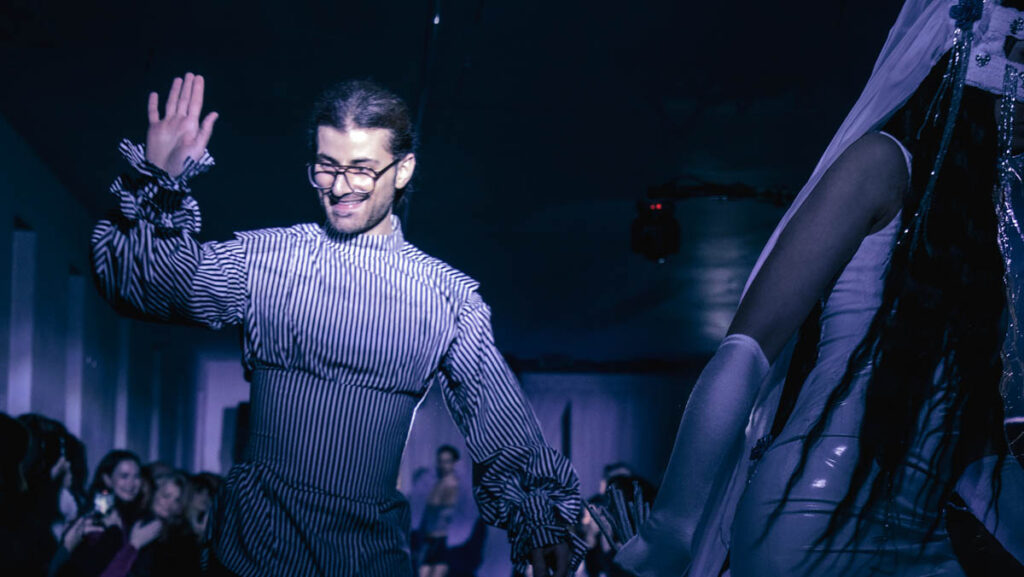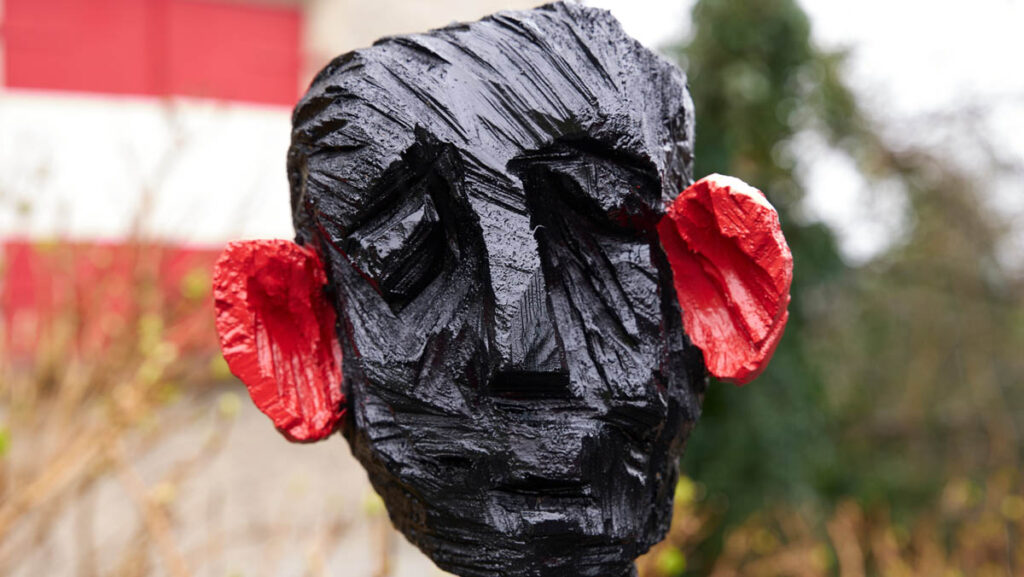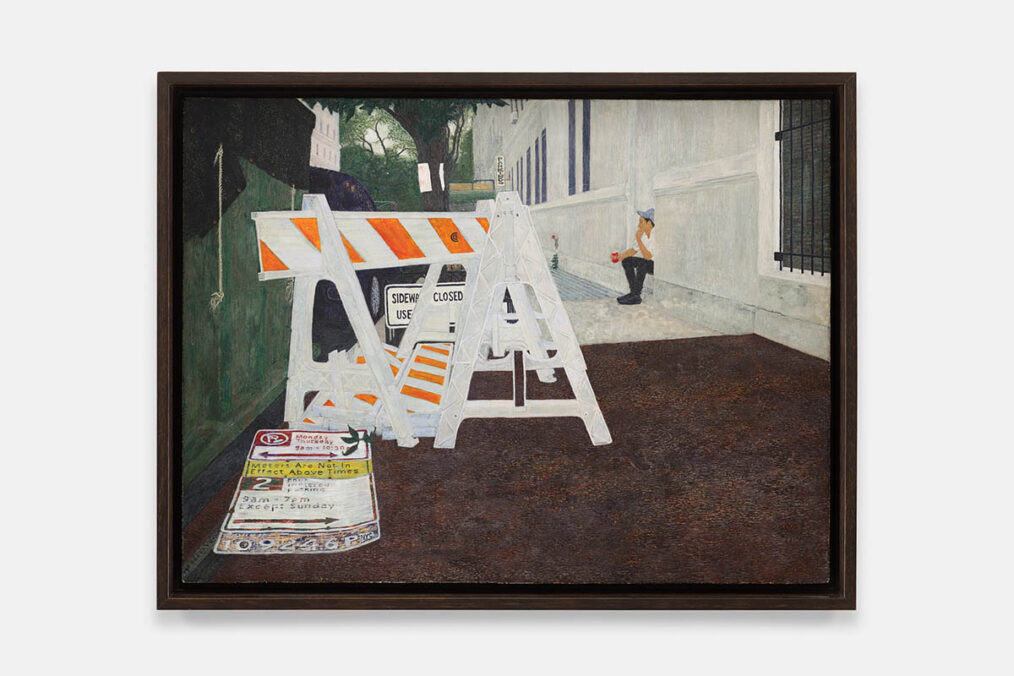
Hamburger’s urban landscapes depict decay and the labor––from resodding park lawns to painting caution lines on subway steps––required to prevent further degradation. In fine brushstrokes of an egg tempera paint that Hamburger makes herself, she creates beautiful works that nod to myriad art historical references. While presenting the challenges inherent in maintaining order – both in the constructed worlds that surround us and in ourselves – she manages to retain levity and humor in her works.
Tanya Traykovski: Why did you decide to become an artist?
C’naan Hamburger: I think I have an academic inclination of sorts. I like to delve into things, I like to read. I dropped out of high school to become a professional skateboarder; my education was dismal because I moved around so much and I got so behind that there was a point where I didn’t think I could even catch up anymore. In art, there’s freedom from having academic training. So there’s an active mind, combined with a tactile element, too. And I always drew. Perhaps I also became an artist because English is not my mother tongue. Although it has become my primary tongue, it remains a product of my peripatetic life and fractured education. I have separate languages to feel each stage of my life and loves–– including languages I have mostly forgotten. My lack of an umbilical connection to English and my locations has led me to see the malleability and fragility of all that surrounds me.
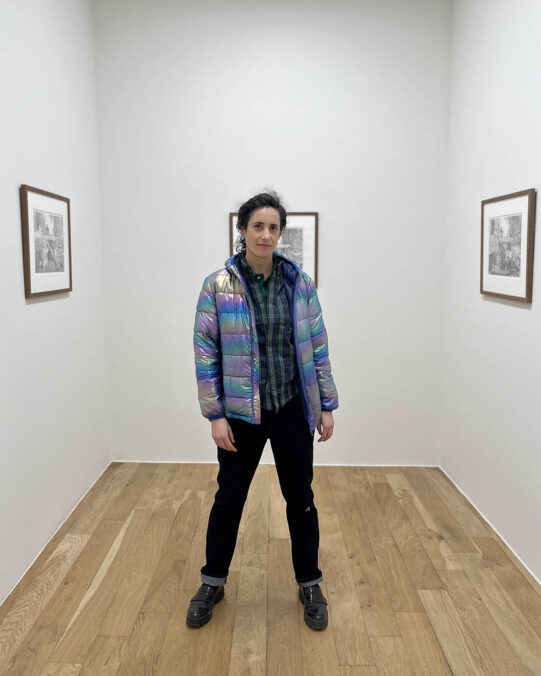
C’naan Hamburger, Courtesy of the artist and Charles Moffett gallery
TT: How did skateboarding influence your artistic practice and does it continue to do so today?
CH: Skateboarding and art intertwine. I had a great arts education through skateboarding. Mark Gonzales is a legend who would create drawings and short stories for Thrasher magazine. He had his own skate company later and his drawings were such a big part of it. And another skateboarder Neil Blender would do wild things – like in the middle of a contest start rolling around on the ground and doing a whole performance and then spray paint on a wall. He would throw in a great trick, just so you knew he could do it. It was a protest against the contest because skateboarding was being overly formalized (which is very similar to art making today). I think I was also able to gain an understanding of art because sometimes skate culture was appropriated into high art, for example in advertising, there was always a play of high and low. Physically interacting with architecture is also unique to skateboarding.
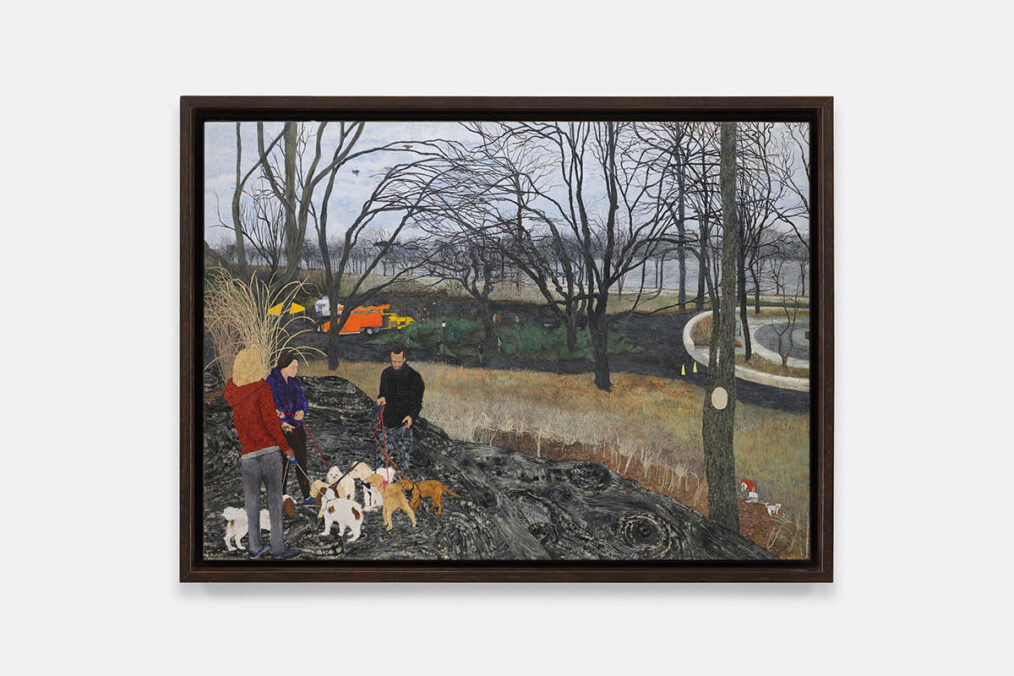
C’naan Hamburger, Vanitas, 2023, Egg Tempera, pigment and ground Manhattan Schist on panel. 28 x 39 inches. Photo by Andy Romer, courtesy the artist and Charles Moffett.
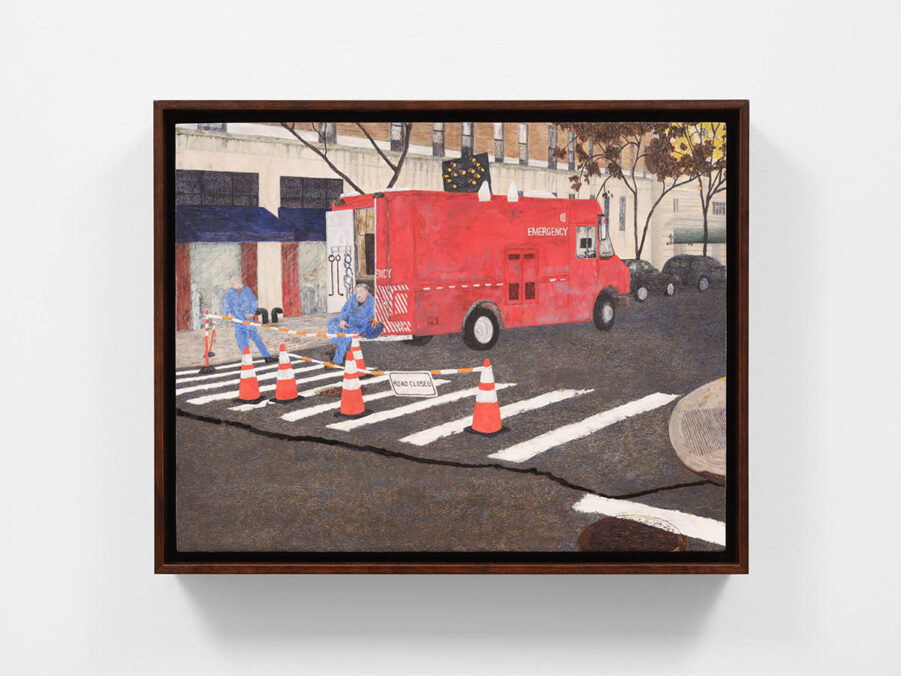
C’naan Hamburger, Janus, 2024, Egg Tempera, pigment, ground meteorites and YIn Mn Blue on panel. 14 x 18 inches. Photo by Thomas Barratt, courtesy the artist and Charles Moffett.
TT: Egg tempera, an ancient type of paint, is your preferred medium and what you’ve used for paintings in this show. And you make it yourself, often with site specific materials such as schist blended into the paint. Can you explain why?
CH: There was this moment in grad school where a group of painters were talking. I was kind of on the outside as I hadn’t fully committed to being a painter at this point. I overheard them waxing poetic over a cadmium that Williamsburg paint puts out. They were describing this emotional relationship with all these brands. But you’re buying a brand of paint. And squeezing it, and I know that there’s a whole theology behind paint from the tube. And mixing paint. But I think that I am attracted to making it all. Egg tempera is traditional but I think, at this point, the opposite of tradition is a tradition in itself. The lines are quite blurry. And it’s quite transgressive to not subscribe to those rules.
TT: While your work addresses the weighty theme of the futility of attempting to delay entropy, there is also a lot of humor in it. Could you please highlight some of the humorous passages?
CH: I like to play little compositional games. For example, in Janus, there are a lot of two-faced architectural motifs throughout the work: the arrows, the crowbars and the Siamese connections are facing opposite directions. In terms of the figures, you have one looking at the other while he is looking away. We live in such tight quarters in New York. Even when you’re talking to someone perhaps they’re also looking away; we’re together, but alone, which also can be kind of funny. In Vanitas, there’s a woman picking up dog poop holding a Vanity Fair bag. Some trees take on these gestural qualities. When walking through the park, one doesn’t feel how our gestural trees are, how they too have personalities. Oh, how jarring that something else can have a personality! In Theater is the Domestication of an Audience, the barriers have a lot of personality and humor as well. I certainly get a chuckle out of the many masterful renderings of horse behinds from the Renaissance! These barriers echoed those in my mind. The barriers assembled and disassembled in several positions had a very academic, still life feel. But academic is funny too! And in Painting Class, the arm the painter holds up becomes a silhouette of the handrail. And so the object and the person become a bit interchanged in a lot of my pieces.
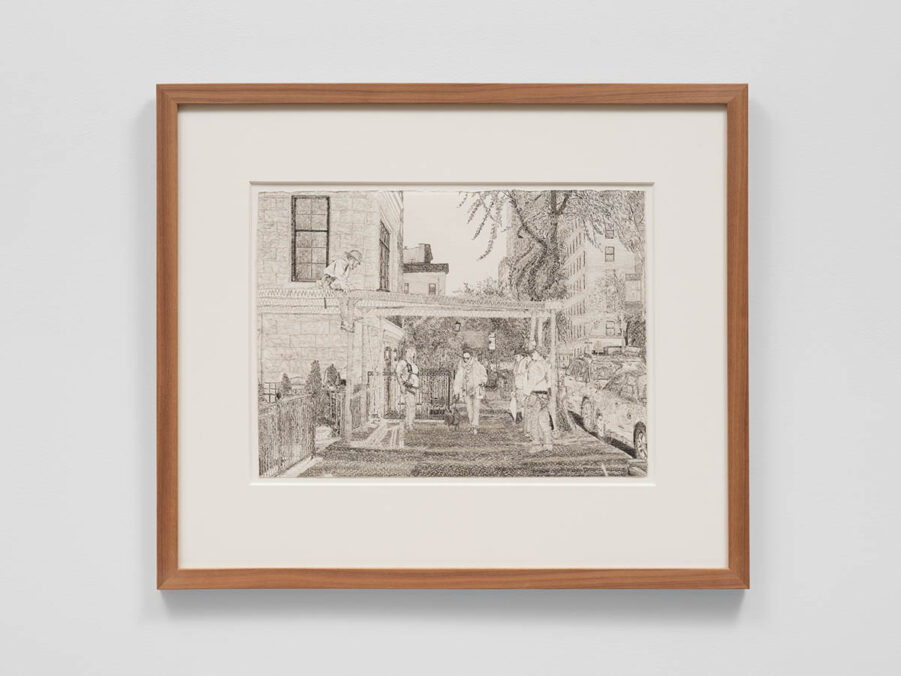
C’naan Hamburger, 14 Stations of the Scaffolding, 2023, Pen on paper. 11 x 15 inches. Photo by Thomas Barratt, courtesy the artist and Charles Moffett.
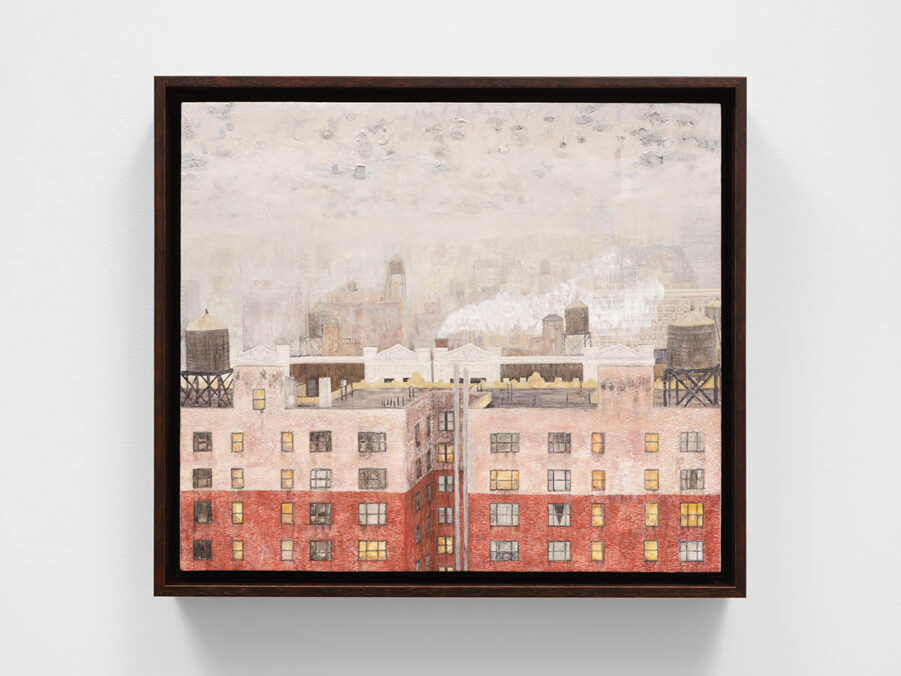
Photo of Participant, 2024 (Photo 6 in dropbox file – photo credit Andy Romer.)
TT: Your proprietary process of creating drawings on steel seems in some ways metaphorical to the central theme of the show because it’s destructive, but you create something beautiful. How did it come about and what do you like about it?
CH: I have to wear a intense respirator because the process of burning through enamel on steel is very toxic. Burning provides an effect that is visceral. The bricks I depict come to life on a particle level! I came up with this process because I have a lot of drawings. Drawing is the basis of everything that I do. And I was wondering, what else can I do with these drawings? At school, I had access to a laser scanner and printer, and it just didn’t work. But I thought, why don’t I try burning steel plates myself, manually. And it worked! So just from a process perspective, I was mimicking something, mining technology and learning from it. And to be fair, I think I learned how to paint through Photoshop; while I don’t use Photoshop to make paintings, technology has given me lessons.
TT: You have many art historical references in your work. The most obvious of which is Pieter Breugel’s Hunters in the Snow for your work Vanitas, but others are more subtle. Can you talk about a few of them?
CH: In my drawing series, I took on the most Renaissance trope I knew. It’s based on the raising of the cross, and it’s called 14 Stations of the Scaffolding. It includes 14 stations because there are seven drawings of raising the scaffolding, the lever process. And then there’s a woman who emerges from the background in seven stages as well, walking her dog. Scaffolding is this omnipresent thing in New York. And people are carrying these heavy things, burdened, and I asked myself, where have I seen that before? There is an element of suffering related to all the labor we do in New York. And there’s also the communication that happens. In these works, I completely stole a quote from Nicolas Poussin’s Landscape of a Man Being Killed By a Snake here too; I felt especially moved to mention him in this series because of his experiments in controlled theater and the depiction of landscapes through the lens of time— I find his moves and especially, the stare of the man looking at the other being killed by the snake, to be particularly effective. I wondered if that can be evoked without such high stakes (as death). Just to twist things up, there are also a lot of modernist compositions that I play with. The composition of Painting Class comes from Piet Mondrian!
TT: The last work you made, Participant, is formally different from the others as it is devoid of people. You’ve talked about disappearing ancient cities as they relate to the work. Can you please explain?
CH: I wondered what it would look like to make a city without people, but that implies people, so that it’s not a ghost town, it’s not creepy. In Participant, the smoke and fog almost erase all the high rise buildings. All that remain are the low brick buildings. And that was a nod to the vanitas, that’s the fleeting part most explicitly. But simultaneously, as solid as the city looks, it’s pretty fleeting as well. That sort of play lends itself to thinking of architecture. Historically, all American architecture nods to another time. You’ve got your Baroque quote, you have your Renaissance quote, you have your Modernist quote, and I think of destroyed cities. When you’re quoting from another civilization, what does that mean towards ours?
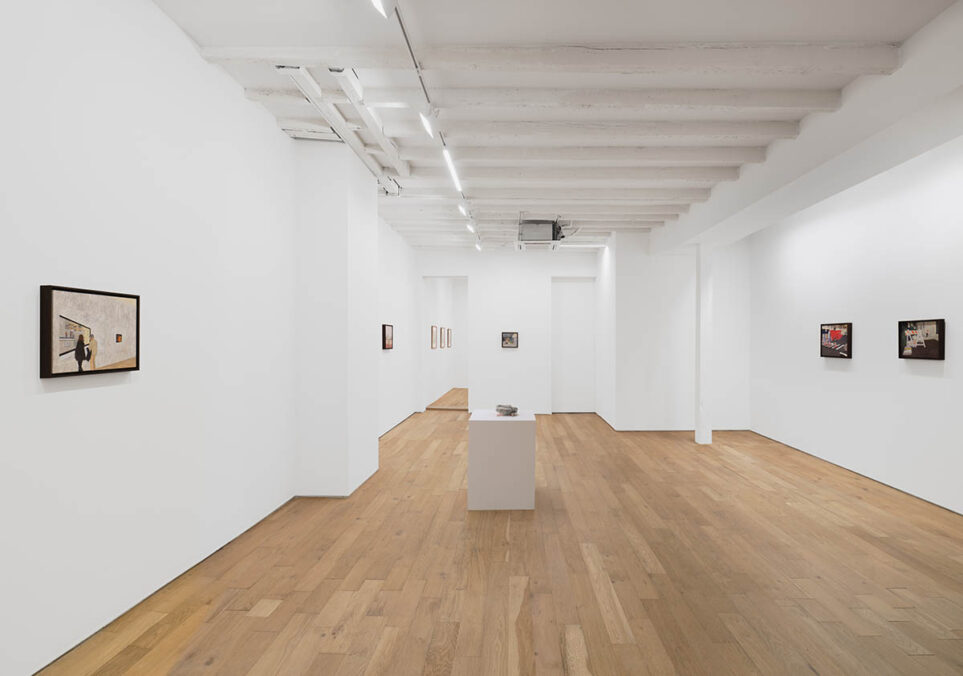
Installation Images_Photos by Thomas Barratt, courtesy Charles Moffett
TT: What makes you happy?
CH: Becoming part of the artistic community quite suddenly, has been quite a treat. I love skatingboarding. I love time with my family. I think my kids have the best ideas; I know I talk about the Renaissance a lot, but actually my kids came up with most of my ideas. When in conversation I encounter awkwardness, and succeed in filling it with patience, with silence, breathing in and out the tension, listening for the quiet song that pleases my sense of music, and using it to search for something with the breath of life inspiring it. In this rare peace I find much happiness.
*Until April 20th at Charles Moffett, 437 Washington Street – 2nd Floor, New York, NY
C’naan Hamburger is a Jerusalem-born, New York-based artist. She earned her MFA from Hunter College in December 2023. Her work is held in permanent collections of the Bartow-Pell Museum, Bronx, NY, and UMass Dartmouth, Claire T. Carney Library Archives and Special Collections. Before pursuing her artistic practice, she was a World Champion Skateboarder, named best female skater of 2001 by Transworld Skateboard Magazine; and in 2000, she won the World Cup of Skateboarding and the Vans Triple Crown in Women’s Street.
Tanya Traykovski holds an A.B. in Art History from Duke University, and an M.A. in Modern and Contemporary Art History from Christie’s Education. The founder of TT Fine Art, she has over ten years of experience in identifying emerging artists who have gone on to achieve widespread market, critical, and curatorial recognition on behalf of collectors and collecting institutions. After an earlier career in high-end retail including positions in the Paris-based buying office of Barneys New York and with Joyce Boutique in Hong Kong, she greatly enjoys discovering and reporting on new talent in one of the art world’s global centers, her home city of New York.



